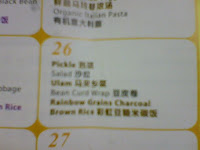The mamak stall near my apartment is very attentive to their customer's needs & wants. When I told them that I wanted vegetarian (not many lay persons are familiar with the term 'vegan') fried noodles, they said okay but they will leave out the 'sambal' (chilli paste) and use sliced chilli instead & no egg.
Try asking for your roti canai with a twist : instead of Roti Telur, ask the mamak to make Roti Sayur! Just stretch out the roti and sprinkle with sliced cabbage, sawi (mustard leaves) & carrot strips. Fold in and fry on a griddle as usual. Serve with dhall curry (leave out the sambal ikan bilis, though).
When I asked the 'wantan' mee (egg noodles) man, he immediately knew what to do -- 'chai' mee he shouted to his wife (the cook). Curious, I waited. It came as egg noodles tossed in dark soya sauce, with only a few blanched mustard leaves on top! (and charged RM1.50, instead of RM3.50 for the usual meat version)
If you like 'yong tau foo' (sorry no English translation), my suggestion is just to order chee cheong fun & deep fried foo chok (beancurd pieces). To lessen the oil content get the seller to soak the foo chuk for a longer time (til its soft) to remove residual oil (learned this from a Japanese cookbook). Go easy on the dark sauce which is very sweet.
My current fad is to go for 'steamboat-on-a-stick' or 'lok-lok' or satay celup, a local favourite eating past-time. The customers stand around an opened concept van. There are rows & rows of skewered seafood/fish/meat balls in all variants. The only choice I have is kangkung (veg) wrapped into tight balls & skewed on a bamboo stick & skewered foo chuk (deep fried beancurd pieces). I can also have the Japanese beancurd stuffed with shredded cucumber. Sometimes, there may be mushrooms, too. All these are dipped into a boiling pot of water & eaten with a choice of 3 sauces - a dark sweet sauce, satay peanut sauce and sour/spicy sauce. The sour/spicy sauce is the healthiest, I guess.
A new innovation is a hot pot of dark looking oil (sitting quietly) for you to deep fry your choice. BEWARE that you do not accidentally drip water (from the ice used to keep the food fresh) into the pot!! I almost did. Did not realise the pot of oil. So watch out!
For dinner at the Malay stall, don't order noodle soup because their soup base is either beef or chicken stock. You can only have stir fry noodles which is rather oily. Make sure to ask if they put eggs in it. Best alternative, order stir-fry 'sayur campur' (mixed veggie) but remember to tell them no chicken, beef or seafood which is usually added in tiny strips.
2. Bring 'backup' food / snack eg. a muesli bar or dry fruits/nuts or vegan biscuits in a small container wherever you go. I sometimes have to wait an hour for my bus & often get hungry. So, I usually spread some jam or peanut butter on a wholemeal slice of bread & bring it along. A packet of soya milk(Yeo's less sugar) from 7-eleven if you don't have time to 'tah-pau' (pack a snack). This prevents you from following your 'nose' & succumbing to your desires.
3. Check 'vegetarian' restaurant/stalls for nutritional value. At many Chinese vegetarian (chai) places (restaurants or road-side stalls), to make up for the absence of tasty meat, they tend to add more artificial flavouring & tons of oil to make the food look good & appetising. Many try to mimic real meat, thus we have 'chai' meat. Also notice that in 'chai' shops, they do not use onion or garlic, only ginger. I always find it strange that in Cantonese dialect, 'choy' means vegetable, but vegetarian shops are called 'Chai' shops instead. Can anyone enlighten me on that?
Indian vegetarian shops serve lassi (yogurt), paneer (cheese), tairu (buttermilk) & have milk in some of their dishes & desserts (eg. payasam). Some dishes are oily / deep fried (eg. bahji, puri, vadai).
As far as I know, I have never met a Muslim vegetarian! But they do eat lots of raw herbs & veggie (called 'ulam') but topped with sambal belachan (made with prawn paste). This is a 'kampung' (village) style food. On the east coast, they have nasi kerabu & nasi ulam. This is rice salad with raw veggie & sambal & 'budu' (another kind of seafood paste). They also have deep fried taukua (soya beancurd) & tempeh. Some types of sambal do not have shrimp paste. So choose carefully. Good as topping for the 'ulam'. Beware the 'air assam' dressing for grill fish. It sometimes has belacan in it.
4. Get food delivered for lunch. This eliminates the stress of looking for nutritious, organic vegan food and possible relapse into meat eating. Very important, especially in the first two weeks of conversion. Try the organic, vegetarian fare @ Green Meadow Cafe. It has a 31-day menu of various palatable & nutritiously caliberated meals by their in-house nutritionist. This includes charcoal brown rice with a variety of dishes & salads/pickles; brown rice dumpling ('chang'); spaghetti; nasi ulam; briyani; porridge, california roll. The only setback is the price, RM200 for 14 days.






No comments:
Post a Comment